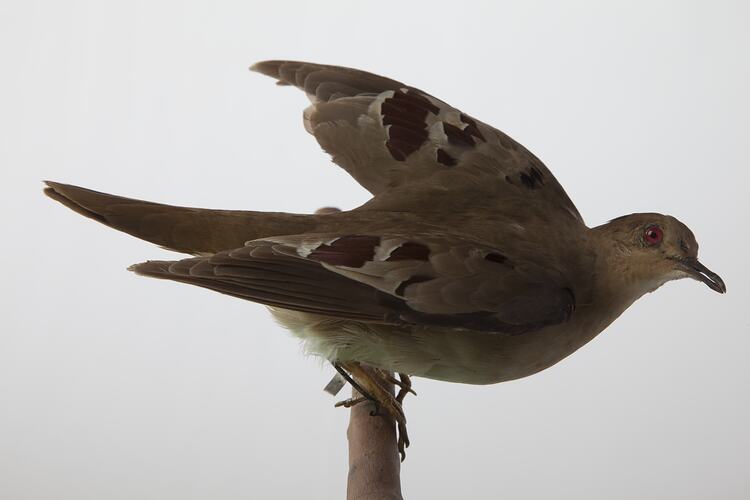
A purple-winged ground dove (Paraclaravis geoffroyi) that is fond of bamboo and once called the South American Atlantic Forest in Brazil, Argentina, and Paraguay its home could now be tracked down through its song.
Scientists are faced with the question about whether the bird’s sound could be used to figure out if any of them still exist. This might sound like a far-fetched idea, but it is actually feasible.
Experts often turn to bioacoustics, a fancy term for using sound to study the environment. They’ve applied this method to record dolphin communication and observe bats from a distance to prevent the spread of viruses.
Thanks to artificial intelligence, researchers can analyze vast audio datasets and teach computer programs to identify different animal sounds amidst the natural noise of their surroundings.
Recordings of this unique dove
Locating recordings of the purple-winged ground dove singing is as tough as finding the bird itself. Carlos Araújo, an ecologist at the Instituto de Biología Subtropical, stumbled upon a potential lead while watching a 1985 interview with Carlos Keller, a former bird breeder in São Paulo. Keller had a few of these doves, and they happened to sing during the interview.
With Keller’s assistance, Araújo and his team managed to dig up this decades-old recording and extract the distinctive song of the purple-winged ground dove. The real challenge, though, was figuring out if it was possible to pick out individual bird songs from the jumble of other sounds in the forest—birds chirping, leaves rustling, rain falling, insects buzzing, and larger animals moving about.
Taking a strategic break, the team shifted their focus to three endangered bird species in Foz do Iguaçu, a national park on the Brazil-Argentina border: the cherry-throated tanager, the Alagoas antwren, and the blue-eyed ground-dove.
These birds share habitats with the elusive purple-winged ground dove. Interestingly, the blue-eyed ground dove’s tale brings optimism. It vanished in 1941 and was rediscovered in 2016.
Strategic placement of recording devices
The scientists strategically positioned thirty recording devices in green areas across the Brazilian part of Foz do Iguaçu, capturing sounds from July 2021 to April 2022. Additionally, data from one hundred recorders on the Argentinian side of Foz was also utilized.
Benjamin Phalan, Head of Conservation at Parque das Aves, a conservation-focused institution in Foz do Iguaçu, led the effort. The team sought out the Guadua trinii bamboo, a key element in the birds’ habitat.
The flowering season of this bamboo occurs roughly once every thirty years and aligns with the habits of the purple-winged ground dove and the other three bird species.
Challenges posed by the forest
Navigating through dense bamboo, the team faced challenges such as ticks, flies, and the ever-present threat of venomous snakes, particularly jacaracas pit vipers. While encounters with these snakes are rare, precautions were taken, with the team wearing galoshes or gaiters to safeguard against potential snake encounters.
The recording devices were set to capture one minute of sounds from the landscape every ten minutes, resulting in a whopping three thousand days’ worth of recordings. Sorting through this vast amount of data also posed a significant challenge!
Signal template to monitor the bird songs
Starting from scratch, the team, armed with limited data for the three endangered bird species, took a unique approach. Araújo first crafted a signal template mirroring the birds’ singing, based on just a handful of recordings.
The algorithm then compared this template to the recorded soundscape, distinguishing between the bird’s signal and background noise. If a detected sound resembled the template, chances were it belonged to the sought-after bird.
David Donoso, an ecosystem ecology researcher at Technische Universität Darmstadt in Germany, praised the study’s use of a statistical model, stating that it demonstrated an innovative application of existing methods.
Donoso, who recently employed bioacoustics to study the recovery of Ecuador’s Choco region, emphasized the versatility of bioacoustics, which may be used to either map entire animal soundscapes with fewer recordings or seek out specific sound patterns with extensive recordings.
The purple-winged ground dove, Claravis geoffroyi
CE as of: 2016
Range: Argentina; Brazil; Paraguay
Major threats: habitat clearance and fragmentation
Conservation actions: protected by Brazilian law; exists within several protected areas pic.twitter.com/r1bz84CJWx— Brit Garner (@BritGarner) March 19, 2018
The team’s tool successfully identified the cherry-throated tanager and blue-eyed ground-dove songs but encountered challenges with the Alagoas antwren, as reported on October 23rd in Bioacoustics.
Araújo noted they are working to enhance the algorithm’s precision for the antwren and simultaneously training it to recognize the purple-winged ground dove. “We’re aiming at both goals at once because we’re running against the clock to find these birds,” Araújo stressed. Ultimately, he expressed the team’s pursuit of a “ghost”—not a silent one!
See all the latest news from Greece and the world at Greekreporter.com. Contact our newsroom to report an update or send your story, photos and videos. Follow GR on Google News and subscribe here to our daily email!



